Mixed surface touring
#1
Senior Member
Thread Starter
Join Date: Dec 2010
Location: northern Deep South
Posts: 8,904
Bikes: Fuji Touring, Novara Randonee
Mentioned: 36 Post(s)
Tagged: 0 Thread(s)
Quoted: 2604 Post(s)
Liked 1,933 Times
in
1,213 Posts
Mixed surface touring
For those of you who have toured on dirt or gravel, as well as pavement, how much slower do you ride off-road? Average pavement speeds and average dirt/gravel speeds would be nice.
I'm wondering how much of a difference it would make in daily mileage for planning purposes.
I'm wondering how much of a difference it would make in daily mileage for planning purposes.
#2
Senior Member
That is going to vary widely depending on the surfaces involved and whether it is only the surface or also more and/or steeper climbs.
I have done some mixed surface where I did about half the mileage on the dirt days, but the surface was poor and there was a lot of steeper climbing. That said I can imagine anything from a small differential on good gravel roads to getting slowed down to walking speed on some surfaces. If unsure, I'd try to just be sure to have an open ended schedule.
I have done some mixed surface where I did about half the mileage on the dirt days, but the surface was poor and there was a lot of steeper climbing. That said I can imagine anything from a small differential on good gravel roads to getting slowed down to walking speed on some surfaces. If unsure, I'd try to just be sure to have an open ended schedule.
#3
Bike touring webrarian
I am definitely slower on dirt than asphalt. I think much of the reason is that dirt roads aren't as smooth, so more bumps (little ups) and more swerving to avoid debris and holes. In addition, dirt roads tend to follow the terrain with lots more short, steep ups then on roads. It is, of course, hard to generalize on speed, but on a recent trip in Italy and Switzerland, I'd estimate 2 MPH slower on dirt.
#4
bicycle tourist
It depends a lot on the type of gravel road.
Normally I'm not that fast while touring on pavement, ~10mph and slower than I used to be. Generally I think less of speed and more of distance per day. Now my sweet spot is closer to 50 miles/day. 30 years ago it was closer to 85 miles per day.
There are gravel roads treated, often treated with oil, that ride almost as smooth as pavement. A lot of the Prudhoe Bay road is like that. On such roads, when they are dry, it doesn't make much difference at all on speed or average distance per day.
Such roads when wet, can sometimes have soft spots or even to texture of peanut butter roads. Speeds and distances go down a lot, in the worst cases I've taken a rest day. Mud can get in the drive train (I torqued off a derailer on the Prudhoe Bay road, some Swedish cyclists I met had enough mud in their Rohloff hubs they stopped working).
Some gravel roads can have more soft stuff graded on top. The road across Siberia had a bunch of that. On average that meant we tried for 80 km/day averages instead of 100 km/day averages we were doing before. Such a ~20% drop in average daily distance was also about average on TDA roads we rode across Africa and for roads I did in Argentina.
There are gravel surfaces that are badly corrugated. Often I've found I can avoid the worst by picking different "lanes" but then you have to watch the softer stuff from side to side. In worst cases, I'm probably reducing distances and speeds ~40% though I'm also looking for alternatives.
I am cautious in my descents on pavement. I become more cautious on gravel. That was the largest issue I found trying sections of the Great Divide on my touring bike. Others not as fearless can do much better there.
So in my past experiences it depends a lot but 20% is a reasonable median where it can be a lot less with good surfaces or lot more for me depending on corrugations, soft stuff, mud and hills.
Normally I'm not that fast while touring on pavement, ~10mph and slower than I used to be. Generally I think less of speed and more of distance per day. Now my sweet spot is closer to 50 miles/day. 30 years ago it was closer to 85 miles per day.
There are gravel roads treated, often treated with oil, that ride almost as smooth as pavement. A lot of the Prudhoe Bay road is like that. On such roads, when they are dry, it doesn't make much difference at all on speed or average distance per day.
Such roads when wet, can sometimes have soft spots or even to texture of peanut butter roads. Speeds and distances go down a lot, in the worst cases I've taken a rest day. Mud can get in the drive train (I torqued off a derailer on the Prudhoe Bay road, some Swedish cyclists I met had enough mud in their Rohloff hubs they stopped working).
Some gravel roads can have more soft stuff graded on top. The road across Siberia had a bunch of that. On average that meant we tried for 80 km/day averages instead of 100 km/day averages we were doing before. Such a ~20% drop in average daily distance was also about average on TDA roads we rode across Africa and for roads I did in Argentina.
There are gravel surfaces that are badly corrugated. Often I've found I can avoid the worst by picking different "lanes" but then you have to watch the softer stuff from side to side. In worst cases, I'm probably reducing distances and speeds ~40% though I'm also looking for alternatives.
I am cautious in my descents on pavement. I become more cautious on gravel. That was the largest issue I found trying sections of the Great Divide on my touring bike. Others not as fearless can do much better there.
So in my past experiences it depends a lot but 20% is a reasonable median where it can be a lot less with good surfaces or lot more for me depending on corrugations, soft stuff, mud and hills.
#5
Senior Member
Join Date: Aug 2010
Location: Madison, WI
Posts: 11,208
Bikes: 1961 Ideor, 1966 Perfekt 3 Speed AB Hub, 1994 Bridgestone MB-6, 2006 Airnimal Joey, 2009 Thorn Sherpa, 2013 Thorn Nomad MkII, 2015 VO Pass Hunter, 2017 Lynskey Backroad, 2017 Raleigh Gran Prix, 1980s Bianchi Mixte on a trainer. Others are now gone.
Mentioned: 48 Post(s)
Tagged: 0 Thread(s)
Quoted: 3461 Post(s)
Liked 1,467 Times
in
1,144 Posts
When I ride my heavy touring bike with 57mm wide tires, I think that I am about 15 to 20 percent slower on gravel than on smooth pavement, but the gravel is much more variable, some gravel is almost as good as chip seal (poor pavement) and some gravel is really nasty.
My Canadian Maritimes trip, I often rode the gravel trails instead of pavement because the pavement was often more hilly and some of the roads lacked shoulders. So, even though it was slower, the lack of traffic and the lack of steeper hills made for a more pleasurable ride.
This road, if a rock was smaller than a tennis ball, I did not bother trying to steer around it.

I thought that much of the C&O was almost as fast to ride on as pavement, even though it was quite wet when I was there.
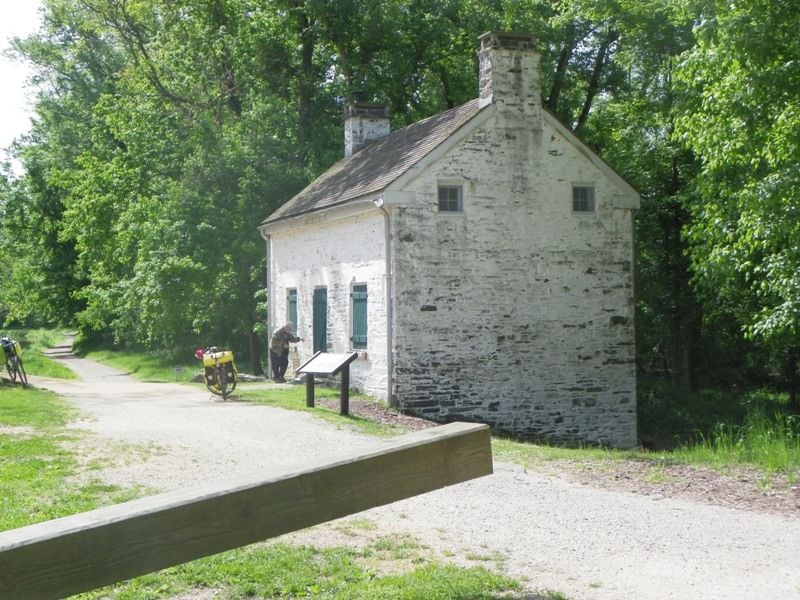
My recollection of the Katy trail was that it was almost like pavement in many places. I remember thinking that they might have added lime to it to consolidate it better. But that was 13 years ago, so my memory may have changed, as the gravel could too.
I am not talking about single track here, I am talking about rail trails or gravel roads that a two wheel drive car can drive on. Roads like White Rim in Canyonlands that is a 4X4 road, that is not comparable.
If I plan to ride on a lot of gravel, I use a bike with 50mm or 57mm tires. If I plan to be almost exclusively on pavement, I am on 37 or 40mm tires.
My Canadian Maritimes trip, I often rode the gravel trails instead of pavement because the pavement was often more hilly and some of the roads lacked shoulders. So, even though it was slower, the lack of traffic and the lack of steeper hills made for a more pleasurable ride.
This road, if a rock was smaller than a tennis ball, I did not bother trying to steer around it.

I thought that much of the C&O was almost as fast to ride on as pavement, even though it was quite wet when I was there.

My recollection of the Katy trail was that it was almost like pavement in many places. I remember thinking that they might have added lime to it to consolidate it better. But that was 13 years ago, so my memory may have changed, as the gravel could too.
I am not talking about single track here, I am talking about rail trails or gravel roads that a two wheel drive car can drive on. Roads like White Rim in Canyonlands that is a 4X4 road, that is not comparable.
If I plan to ride on a lot of gravel, I use a bike with 50mm or 57mm tires. If I plan to be almost exclusively on pavement, I am on 37 or 40mm tires.
#6
Count Orlok Member
I used some of the WI state trails this year, including the Great River, La Crosse River, and Elroy Sparta. I was averaging about 12 mph on good paved roads, but had to cut it back to about 10 mph on the trails. The trail conditions were variable, depending on maintenance and how much usage the trails see.

Great River Trail

La Crosse River Trail
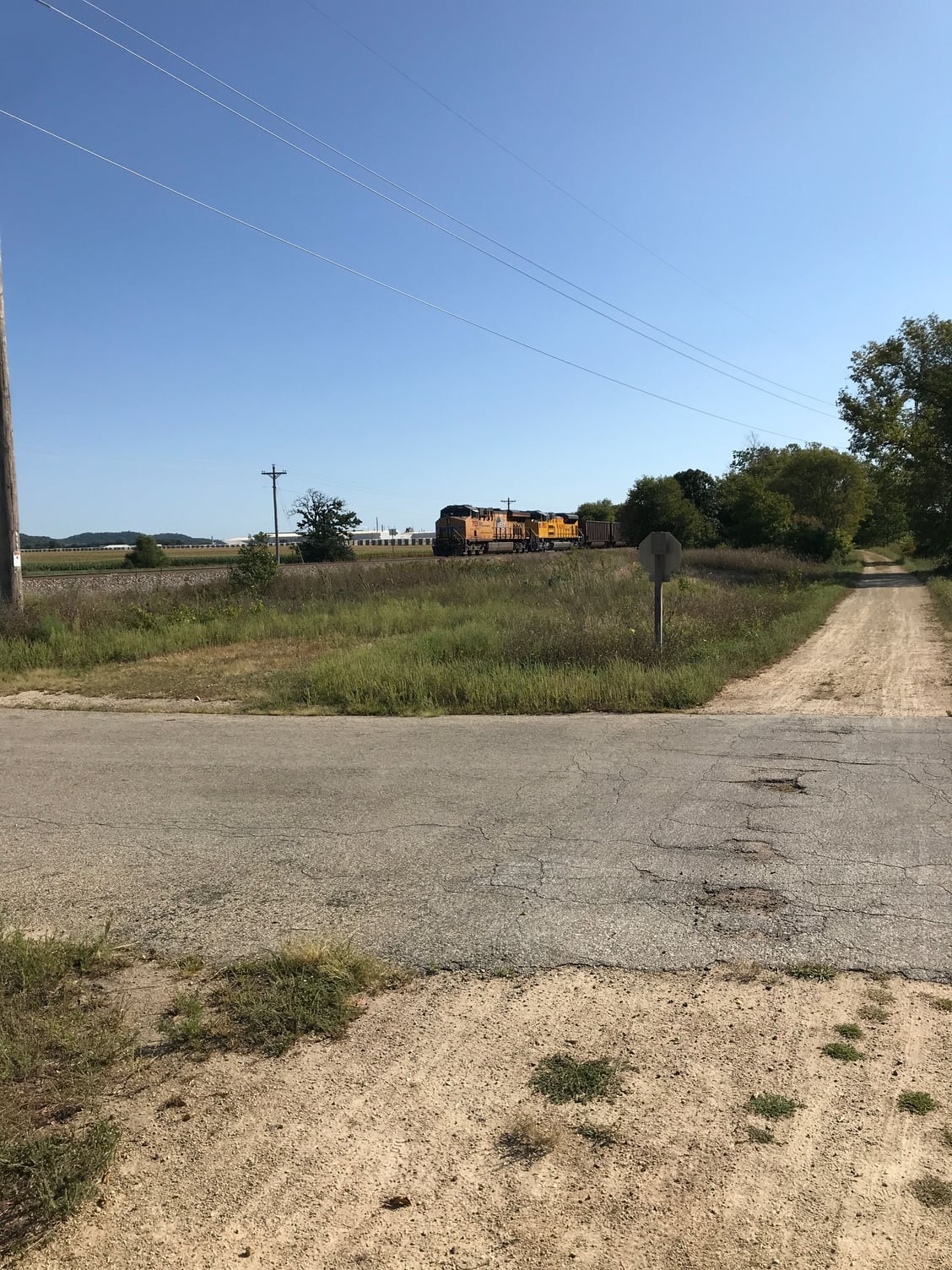
La Crosse River Trail

Elroy Sparta trail
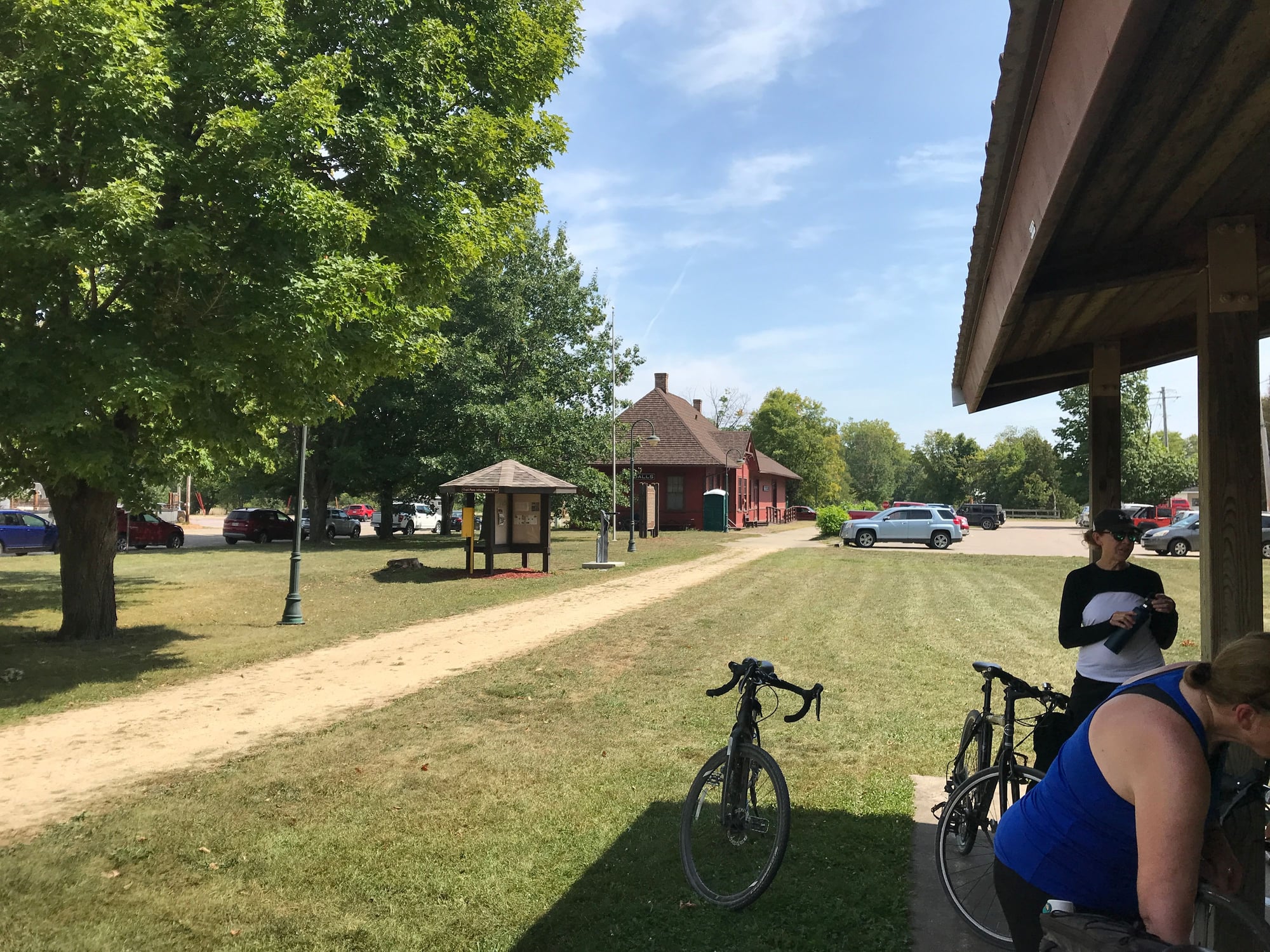
Elroy Sparta trail

Great River Trail

La Crosse River Trail

La Crosse River Trail

Elroy Sparta trail

Elroy Sparta trail
Likes For gna:
#7
Senior Member
Also there is the question of how badly you want to go fast. Look at the cobblestones on the Paris-Roubaix race, those mofos tackle those at full speed on skinny tires. This dude probably should have gone a tad slower...
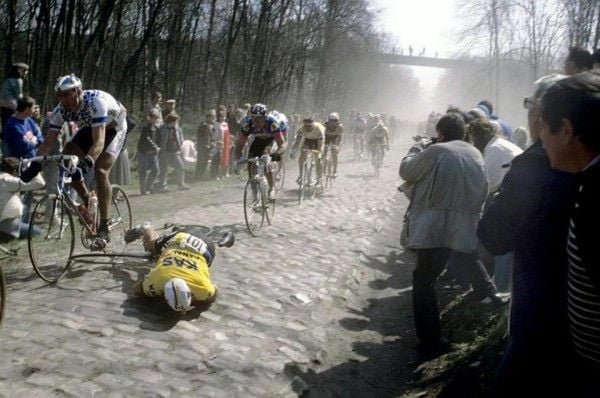
How fast I could go and how fast I'm willing to go are two whole different numbers.

How fast I could go and how fast I'm willing to go are two whole different numbers.
#8
Hooked on Touring
I've done lots of "mixed" touring on all kinds of surfaces. Usually 1.95 MTB 26"; center bead, edge knobs.
My rule of thumb for average dirt is 2/3s of my road speed.
In my younger years an 80 mile-day might be 8 hours on the road, but 12 hours all on dirt.
Usually I'd split the difference and do 70 miles in about 10 hours.
It's a different enchilada when you are riding major gnarly stuff.
My rule of thumb for average dirt is 2/3s of my road speed.
In my younger years an 80 mile-day might be 8 hours on the road, but 12 hours all on dirt.
Usually I'd split the difference and do 70 miles in about 10 hours.
It's a different enchilada when you are riding major gnarly stuff.
#9
Sunshine
Join Date: Aug 2014
Location: Des Moines, IA
Posts: 16,614
Bikes: '18 class built steel roadbike, '19 Fairlight Secan, '88 Schwinn Premis , Black Mountain Cycles Monstercross V4, '89 Novara Trionfo
Mentioned: 123 Post(s)
Tagged: 0 Thread(s)
Quoted: 10964 Post(s)
Liked 7,491 Times
in
4,189 Posts
Pavement- fastest
Hardpacked limestone railtrail- .5 to 1mph slower.
Gravel roads- 1 to 1.5mph slower.
Gravel roads here are hillier than paved roads too, which accounts for some of the slower pace.
Hardpacked limestone railtrail- .5 to 1mph slower.
Gravel roads- 1 to 1.5mph slower.
Gravel roads here are hillier than paved roads too, which accounts for some of the slower pace.
#10
Senior Member
Join Date: Jan 2010
Posts: 39,246
Mentioned: 211 Post(s)
Tagged: 1 Thread(s)
Quoted: 18420 Post(s)
Liked 15,564 Times
in
7,333 Posts
Depends, in part, on surface and grade.Example: Going east on the Route of the Hiawatha is going to be slower than a flat, unpaved trail with a similar surface. I climbed 16 mile Gold Pass out St. Regis, MT. 15 miles were unpaved. I made up time after crossing the ID border on the glass-smooth, paved descent.
I’ve never bothered to keep statistics. I just assume unpaved will take more time. How much time depends in part of the total length of “gravel.”
I’ve never bothered to keep statistics. I just assume unpaved will take more time. How much time depends in part of the total length of “gravel.”
#11
Senior Member
too many variables to take into account
rider power, surfaces, how much your bike weighs, how wide your tires are, your bike handling skills, how much risk you are willing to take to ding yourself or a part of the bike......
I'm already old and slow, have pretty good bike handling skills but recently out on my own on all kinds of varying surfaces, I made a real effort to be smart and take it slower when needed, hike a biked stuff to not risk whacking the rear derailleur or cutting a sidewall, and had no choice but to walk for periods just because it was way easier than trying to ride.
rider power, surfaces, how much your bike weighs, how wide your tires are, your bike handling skills, how much risk you are willing to take to ding yourself or a part of the bike......
I'm already old and slow, have pretty good bike handling skills but recently out on my own on all kinds of varying surfaces, I made a real effort to be smart and take it slower when needed, hike a biked stuff to not risk whacking the rear derailleur or cutting a sidewall, and had no choice but to walk for periods just because it was way easier than trying to ride.
#12
Senior Member
For extremely smooth, densely packed fine gravel, 15-25% slower. Usually closer to 25% unless you're talking the most godly fine packed gravel around.
Anything more rough than that, 35-40% slower.
For borderline mountain bike terrain, 50% slower.
Any more rough than that and it is unridable on road tires. Time to walk.
I'd use a 2/3rds rule for planning purposes.
Anything more rough than that, 35-40% slower.
For borderline mountain bike terrain, 50% slower.
Any more rough than that and it is unridable on road tires. Time to walk.
I'd use a 2/3rds rule for planning purposes.
Last edited by Yan; 10-03-23 at 07:20 PM.
Likes For Yan:
#13
Senior Member
Join Date: Jan 2010
Posts: 39,246
Mentioned: 211 Post(s)
Tagged: 1 Thread(s)
Quoted: 18420 Post(s)
Liked 15,564 Times
in
7,333 Posts
too many variables to take into account
rider power, surfaces, how much your bike weighs, how wide your tires are, your bike handling skills, how much risk you are willing to take to ding yourself or a part of the bike......
I'm already old and slow, have pretty good bike handling skills but recently out on my own on all kinds of varying surfaces, I made a real effort to be smart and take it slower when needed, hike a biked stuff to not risk whacking the rear derailleur or cutting a sidewall, and had no choice but to walk for periods just because it was way easier than trying to ride.
rider power, surfaces, how much your bike weighs, how wide your tires are, your bike handling skills, how much risk you are willing to take to ding yourself or a part of the bike......
I'm already old and slow, have pretty good bike handling skills but recently out on my own on all kinds of varying surfaces, I made a real effort to be smart and take it slower when needed, hike a biked stuff to not risk whacking the rear derailleur or cutting a sidewall, and had no choice but to walk for periods just because it was way easier than trying to ride.
My ex and I rode a 23 mile unpaved stretch that had varying surfaces (from sand to washboards to even a little naked rock) and climbing and descending. She left me in the dust (literally) on the descents because I kept the speed down.
#14
Senior Member
and what I consider being careful could be someone elses fast, or someone elses turtle pace.
but this question is so open ended, other than saying that you are going to be slower is pretty tough to answer.
Get out on some gravel trails and see how you do.
but this question is so open ended, other than saying that you are going to be slower is pretty tough to answer.
Get out on some gravel trails and see how you do.
Last edited by djb; 10-04-23 at 08:24 AM. Reason: to be slower
Likes For djb:
#15
Senior Member
Join Date: Aug 2010
Location: Madison, WI
Posts: 11,208
Bikes: 1961 Ideor, 1966 Perfekt 3 Speed AB Hub, 1994 Bridgestone MB-6, 2006 Airnimal Joey, 2009 Thorn Sherpa, 2013 Thorn Nomad MkII, 2015 VO Pass Hunter, 2017 Lynskey Backroad, 2017 Raleigh Gran Prix, 1980s Bianchi Mixte on a trainer. Others are now gone.
Mentioned: 48 Post(s)
Tagged: 0 Thread(s)
Quoted: 3461 Post(s)
Liked 1,467 Times
in
1,144 Posts
The vast majority of my gravel riding was on rail trails or conventional gravel roads for cars, not 4X4. It is very rare when I have to go slower to avoid falls. And that is where I am thinking I am 15 to 20 percent slower than I would be on pavement.
But one of the trails in my area has had erosion washouts where the maintenance crews shoveled in loose beach sand to repair them. You can be riding along without any problem and suddenly you hit loose sand, I know people that fell in such situations. On that trail I only ride my heavy touring bike because it has 57mm tires that float over that loose sand better than the narrower tires.
That said, I have ridden some mountain bike trails and 4X4 roads, and by being slow and careful, and walking down some steep hills, I avoided catastrophe. There, I was maybe half the speed that I would have been on a paved road.
I recall a bad stretch of washboard on a 4X4 road where my bike computer said I had to stay below 8 km/hr, otherwise the washboard bumps were just too much to ride on. But that is rare.
But one of the trails in my area has had erosion washouts where the maintenance crews shoveled in loose beach sand to repair them. You can be riding along without any problem and suddenly you hit loose sand, I know people that fell in such situations. On that trail I only ride my heavy touring bike because it has 57mm tires that float over that loose sand better than the narrower tires.
That said, I have ridden some mountain bike trails and 4X4 roads, and by being slow and careful, and walking down some steep hills, I avoided catastrophe. There, I was maybe half the speed that I would have been on a paved road.
I recall a bad stretch of washboard on a 4X4 road where my bike computer said I had to stay below 8 km/hr, otherwise the washboard bumps were just too much to ride on. But that is rare.
#16
aka Timi
I’ve just got back from a tour of France, Spain, and Portugal. Followed a fair number of Eurovelo routes: Rhine to Rhône canal, EV6, 15, 8, 3, 1.
In France many of the old canal toepaths and tracks by the rivers have been asphalted and painted with dashed white lines (bit overkill if you ask me). However in Spain the pilgrims’ hiking routes have been included in the EV bike routes, but are really just old, stony goat paths, maybe fit for a mountain bike, but not much more than that.
I often had to use Google Maps ”car without highway” to avoid them.
Speed difference? 50 procent I reckon, but I’m on high inflated 32mm Hardshells. My sighs of relief when getting back to asphalt (or at least hardpacked gravel) must have seemed very strange to the goats and pilgrims.
In France many of the old canal toepaths and tracks by the rivers have been asphalted and painted with dashed white lines (bit overkill if you ask me). However in Spain the pilgrims’ hiking routes have been included in the EV bike routes, but are really just old, stony goat paths, maybe fit for a mountain bike, but not much more than that.
I often had to use Google Maps ”car without highway” to avoid them.
Speed difference? 50 procent I reckon, but I’m on high inflated 32mm Hardshells. My sighs of relief when getting back to asphalt (or at least hardpacked gravel) must have seemed very strange to the goats and pilgrims.
Likes For imi:
#17
Senior Member
Thread Starter
Join Date: Dec 2010
Location: northern Deep South
Posts: 8,904
Bikes: Fuji Touring, Novara Randonee
Mentioned: 36 Post(s)
Tagged: 0 Thread(s)
Quoted: 2604 Post(s)
Liked 1,933 Times
in
1,213 Posts
Thanks to all for the informative responses!
I know the answer is going to be "it depends" (as usual). However, what got me thinking was a combination of surfing across a week-long ride that's advertised as half gravel, half pavement, plus riding a some new-to-me gravel roads over the weekend. I should have hit the "next interval" GPS button on several of these roads, but they were roughly in three buckets:
1. Hard-packed roads with 1" (or larger) gravel
2. Steeper roads with gullies, partially filled with loose... stuff. Part way between small gravel and sand.
3. Fine, packed gravel mixed in with old, rotting pavement.
None of the fine sand (which I have seen and waded back out of) on these roads.
Guess I need to reach back to find out which (and how much) of each in included. Is it just me, or is the RWGPS unpaved designation almost useless, given the MTB to fine packed gravel spectrum it encompasses?
I know the answer is going to be "it depends" (as usual). However, what got me thinking was a combination of surfing across a week-long ride that's advertised as half gravel, half pavement, plus riding a some new-to-me gravel roads over the weekend. I should have hit the "next interval" GPS button on several of these roads, but they were roughly in three buckets:
1. Hard-packed roads with 1" (or larger) gravel
2. Steeper roads with gullies, partially filled with loose... stuff. Part way between small gravel and sand.
3. Fine, packed gravel mixed in with old, rotting pavement.
None of the fine sand (which I have seen and waded back out of) on these roads.
Guess I need to reach back to find out which (and how much) of each in included. Is it just me, or is the RWGPS unpaved designation almost useless, given the MTB to fine packed gravel spectrum it encompasses?
#18
Senior Member
pdlamb, what tire widths will you be using? Big factor in how a given surface rides and what can be pretty darn annoying or tiresome if you are really undertired for most of the time. A bit undertired isn't a big deal for me, but it depends on how much and for how long.
If I were to be doing a week long trip on the surfaces sort of what you describe above, the wider the tires you can use will make things faster, more comfortable for you, being more sure footed and frankly just more fun.
How wide can you go with your bike? My 2 cents would be to get some reasonably priced wider tires with an appropriate tread pattern, they don't have to be expensive tires at all, but will certainly increase the enjoyment factor.
for the conditions you describe, I've ridden similar ish stuff on 2in slicks, also 2.1 inch tires with a slickish middle and knobs on edges which give more front end traction on softer surfaces, and also 2.1 inch cross country mtb type tires with moderate tread pattern that give even more traction on varying dirt and gravel but still roll reasonably well on hard packed and pavement.
and no matter the tire, not having too high pressures make all the difference in feel and comfort. Too high a pressure on any tire will be counterproductive.
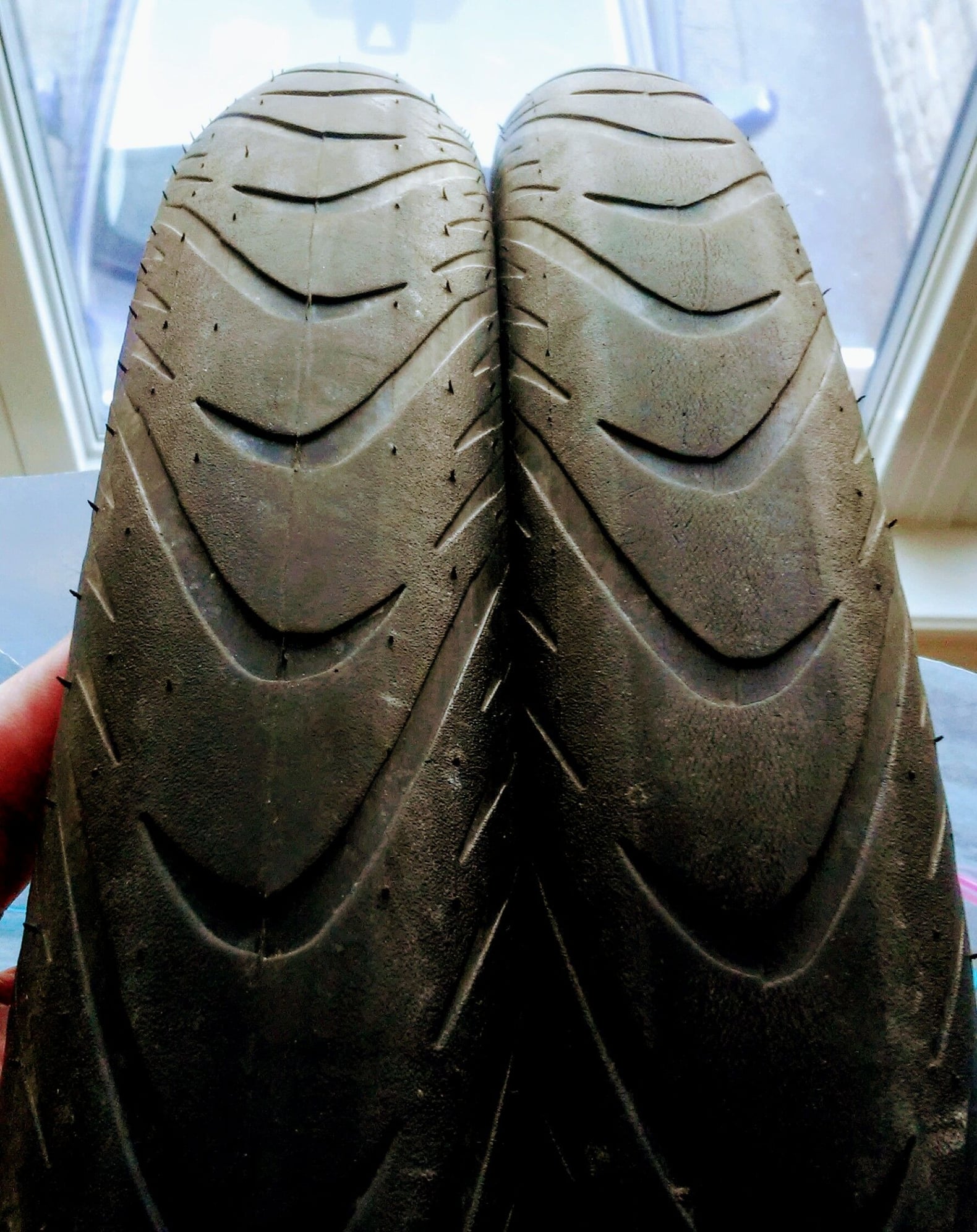

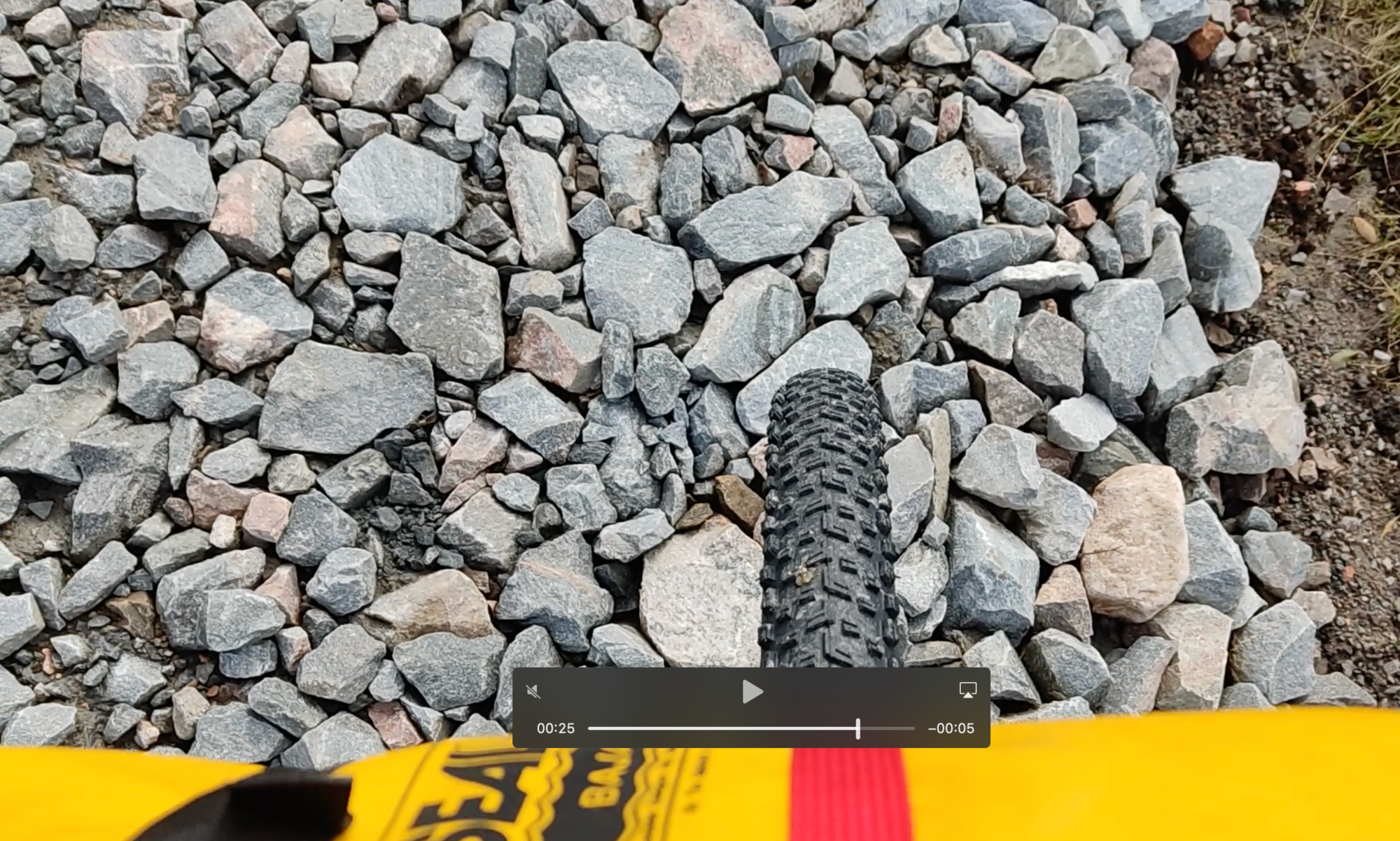
If I were to be doing a week long trip on the surfaces sort of what you describe above, the wider the tires you can use will make things faster, more comfortable for you, being more sure footed and frankly just more fun.
How wide can you go with your bike? My 2 cents would be to get some reasonably priced wider tires with an appropriate tread pattern, they don't have to be expensive tires at all, but will certainly increase the enjoyment factor.
for the conditions you describe, I've ridden similar ish stuff on 2in slicks, also 2.1 inch tires with a slickish middle and knobs on edges which give more front end traction on softer surfaces, and also 2.1 inch cross country mtb type tires with moderate tread pattern that give even more traction on varying dirt and gravel but still roll reasonably well on hard packed and pavement.
and no matter the tire, not having too high pressures make all the difference in feel and comfort. Too high a pressure on any tire will be counterproductive.



#19
Senior Member
If I were to be doing a week long trip on the surfaces sort of what you describe above, the wider the tires you can use will make things faster, more comfortable for you, being more sure footed and frankly just more fun.
How wide can you go with your bike? My 2 cents would be to get some reasonably priced wider tires with an appropriate tread pattern, they don't have to be expensive tires at all, but will certainly increase the enjoyment factor.
How wide can you go with your bike? My 2 cents would be to get some reasonably priced wider tires with an appropriate tread pattern, they don't have to be expensive tires at all, but will certainly increase the enjoyment factor.
for the conditions you describe, I've ridden similar ish stuff on 2in slicks, also 2.1 inch tires with a slickish middle and knobs on edges which give more front end traction on softer surfaces, and also 2.1 inch cross country mtb type tires with moderate tread pattern that give even more traction on varying dirt and gravel but still roll reasonably well on hard packed and pavement.
Edited to add that was with my "vintage" 1990 26" rigid MTB.
Last edited by staehpj1; 10-05-23 at 08:25 AM.
#20
Senior Member
Thread Starter
Join Date: Dec 2010
Location: northern Deep South
Posts: 8,904
Bikes: Fuji Touring, Novara Randonee
Mentioned: 36 Post(s)
Tagged: 0 Thread(s)
Quoted: 2604 Post(s)
Liked 1,933 Times
in
1,213 Posts
pdlamb, what tire widths will you be using? Big factor in how a given surface rides and what can be pretty darn annoying or tiresome if you are really undertired for most of the time. A bit undertired isn't a big deal for me, but it depends on how much and for how long.
...
How wide can you go with your bike? My 2 cents would be to get some reasonably priced wider tires with an appropriate tread pattern, they don't have to be expensive tires at all, but will certainly increase the enjoyment factor.
...
How wide can you go with your bike? My 2 cents would be to get some reasonably priced wider tires with an appropriate tread pattern, they don't have to be expensive tires at all, but will certainly increase the enjoyment factor.
FWIW, I'm not interested in single track, I'll stay with old roads.
#21
Hooked on Touring
One more thing.
Unpaved roads can change dramatically from year to year, even week to week.
A big rainstorm and heavy runoff can trash a dirt road fast.
So, I can tell you I rode Old Mill Road this year and it was smooth as pavement,
and next year when you ride it, it is nonstop washboards that jostle your joints.
Unpaved roads can change dramatically from year to year, even week to week.
A big rainstorm and heavy runoff can trash a dirt road fast.
So, I can tell you I rode Old Mill Road this year and it was smooth as pavement,
and next year when you ride it, it is nonstop washboards that jostle your joints.
#22
Senior Member
Join Date: Aug 2010
Location: Madison, WI
Posts: 11,208
Bikes: 1961 Ideor, 1966 Perfekt 3 Speed AB Hub, 1994 Bridgestone MB-6, 2006 Airnimal Joey, 2009 Thorn Sherpa, 2013 Thorn Nomad MkII, 2015 VO Pass Hunter, 2017 Lynskey Backroad, 2017 Raleigh Gran Prix, 1980s Bianchi Mixte on a trainer. Others are now gone.
Mentioned: 48 Post(s)
Tagged: 0 Thread(s)
Quoted: 3461 Post(s)
Liked 1,467 Times
in
1,144 Posts
...
... I'll just comment on the 2.1" cross country tires. I found that for me someting with lots of low small knobs works suprisingly well even on the pavement on a mixed surace tour. I used some Kenda Slant sixes in that size and was not surprised that they were great on gravel and singletrack. I was surprised how well they worked out for the paved road sections. I didn't mind them at all. I am sure other cross country race tires would work out well too.
....
... I'll just comment on the 2.1" cross country tires. I found that for me someting with lots of low small knobs works suprisingly well even on the pavement on a mixed surace tour. I used some Kenda Slant sixes in that size and was not surprised that they were great on gravel and singletrack. I was surprised how well they worked out for the paved road sections. I didn't mind them at all. I am sure other cross country race tires would work out well too.
....
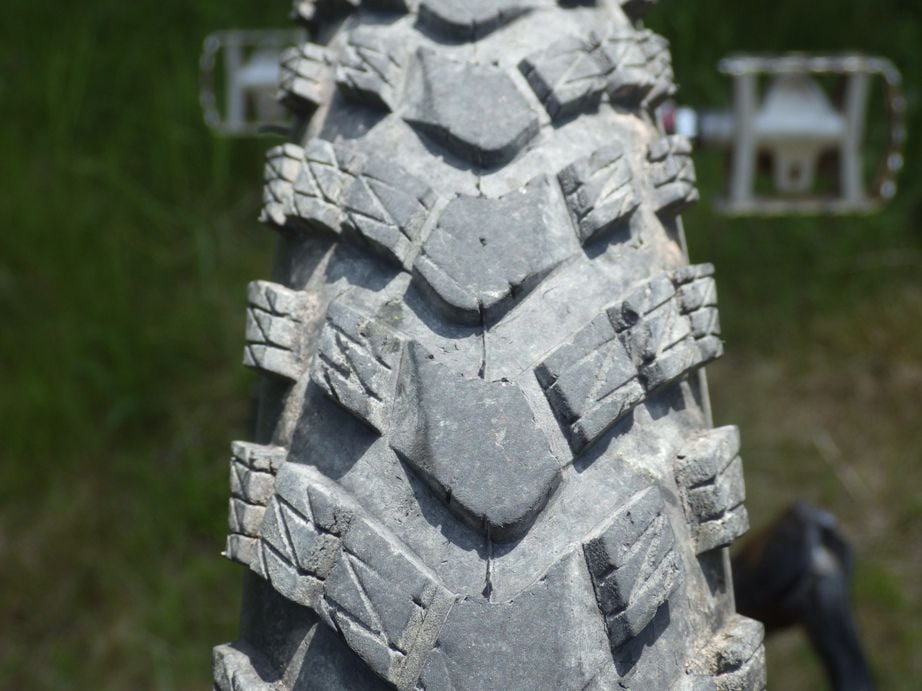
Quite noisy, but very low rolling resistance. They are the discontinued Schwalbe Marathon Extreme tire, the folding version. They looked better new, this was after several thousand miles.
#23
Senior Member
Join Date: Sep 2013
Location: Spain
Posts: 1,070
Mentioned: 4 Post(s)
Tagged: 0 Thread(s)
Quoted: 277 Post(s)
Liked 493 Times
in
238 Posts
For those of you who have toured on dirt or gravel, as well as pavement, how much slower do you ride off-road? Average pavement speeds and average dirt/gravel speeds would be nice.
I'm wondering how much of a difference it would make in daily mileage for planning purposes.
I'm wondering how much of a difference it would make in daily mileage for planning purposes.
My touring is not about speed, how fast or how slow I ride. My touring is about enjoying nature, breath fresh air, far away from big cities and humans.

#24
Senior Member
Join Date: Sep 2013
Location: Spain
Posts: 1,070
Mentioned: 4 Post(s)
Tagged: 0 Thread(s)
Quoted: 277 Post(s)
Liked 493 Times
in
238 Posts
Also there is the question of how badly you want to go fast. Look at the cobblestones on the Paris-Roubaix race, those mofos tackle those at full speed on skinny tires. This dude probably should have gone a tad slower...

How fast I could go and how fast I'm willing to go are two whole different numbers.

How fast I could go and how fast I'm willing to go are two whole different numbers.
LOVE that! did the Amateur Challenge 3 times, 28mm tires
 )
)
#25
Senior Member
I do find that having an open ended schedule and not being a slave to the schedule is a big plus if you can manage that.
I also agree on the being away from cities and enjoying nature part, but meeting the local folks and other travellers is some of the enjoyment of touring for me.
Last edited by staehpj1; 10-05-23 at 02:44 PM.





